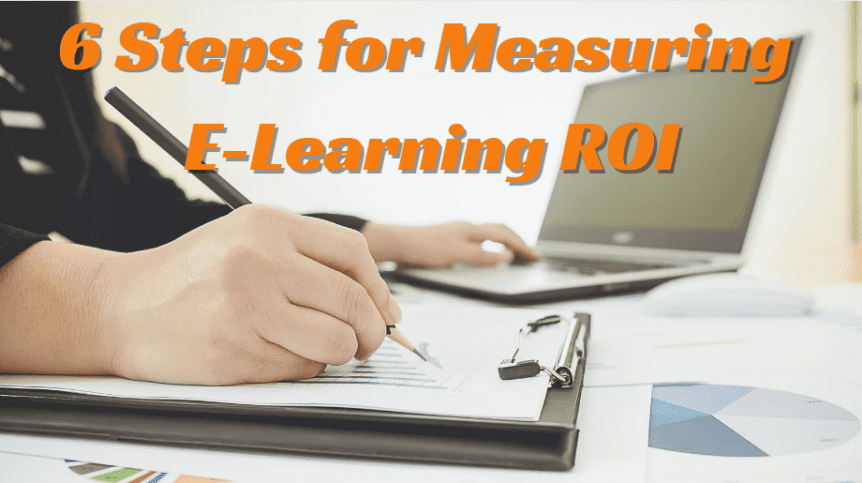6 Steps for Measuring E-Learning ROI
Measuring e-learning ROI and assessing the success of the courses you deliver are important parts of your training strategy and the e-learning development process. Measuring success and, specifically, ROI (return on investment), is not always easy.
After all, the impact of an e-learning course is not just financial. In fact, for some training topics, the objective, tangible, and quantitative financial impact might be impossible to determine.
The following five steps will help you measure e-learning ROI, both financially and in terms of other impacts on your business.
Measuring E-Learning ROI in 6 Steps
Step1: Identify Learning Needs
The starting point is to identify the learning needs you want the training course to address. This could be skills gaps you have identified, or skills employees will need in the future to help the business achieve its strategic objectives.
Step 2: Define Goals
You can’t fully assess success if you don’t have a clear definition of your training goals. In fact, defining your training goals should be one of the first things you do in the e-learning development process as it will not only help you assess success, but also create a better-quality course and optimised learner experience.
There are lots of different ways you can define goals for your e-learning courses. When thinking about measuring e-learning ROI, it is usually beneficial to be as specific as possible.
Step 3: Determine Measurements of Success
The next step is to get an understanding of your measurements of success. Again, it is important to go through this process in the early stages of your e-learning development project.
There are lots of different measurements of success that can apply to e-learning courses, but they typically fall into two main categories:
- Tangible financial benefits
- Intangible and/or non-financial benefits
E-learning ROI is typically a financial calculation where you produce a percentage return on investment. That said, intangible benefits should also be included in reports analysing e-learning ROI in order to give the most complete picture possible.
If goals can be measured financially, include them in the calculation. Other benefits are likely to need more explanation and context. Examples include:
- Behavioural change – behavioural change can deliver financial benefits to your business, but the benefits can also be more difficult to calculate accurately. Staff operating more safely or being better able to identify problems in a process are two examples of benefits that could be financially assessed. Improved teamwork, communication, or leadership skills are harder to quantify.
- Knowledge retention – knowledge retention in the weeks and months after a training course is an important measurement of success, but it is one that is difficult to quantify financially. Product knowledge or the ability to handle difficult situations are two examples. Both can be important goals for a training course, but their impact is mostly subjective.
- Learner engagement – learner engagement is another essential objective of e-learning courses, especially if you can improve engagement with your overall training strategy, helping to build a culture of learning. While important, this benefit is hard to define or assess financially.
- Staff retention – staff retention can often be objectively assessed as you can compare rates in different time periods. It is the contributing factors that are subjective. Training could play an important role, but so could changes in the commercial strategy or enhanced benefits packages. This level of subjectivity can make it more difficult to quantify financially.
Step 4: Calculate Tangible Costs
An essential part of calculating e-learning ROI is understanding the costs of the project. When going through this process, it can also be beneficial to assess the cost of doing nothing, as doing nothing is also likely to have an impact on the business.
If you are transitioning from traditional methods of training, such as classroom-based instructor-led training, to e-learning, the money you save switching to e-learning should also be considered.
The costs of an e-learning development project can include:
- E-learning developers
- Time for in-house staff to contribute to the project
- Technology costs, including the cost of an LMS
- Content creation costs such as videos or images
- Project timescales, including how long it took to develop and then deliver the e-learning course
- Post-implementation costs to get feedback from learners and assess the training’s impact
Step 5: Assess Intangible Benefits
Assessing the intangible benefits of the e-learning course is the next step. This could involve observation and getting feedback from managers and supervisors. Feedback from learners is also important.
Step 6: Communicate the Results
There is not much point in assessing the value and ROI of an e-learning course if you don’t communicate the findings. The results are important to your learning and development team, but they also have a wider business significance.
When communicating the results of your analysis, it is often beneficial to tailor the information for the audience. Senior executives, for example, might be more interested in the numbers and high-level information than the nitty-gritty details.
Continuous Improvements
There are lots of ways you can use an assessment of e-learning value and ROI, including justifying the project and demonstrating the results achieved. It is also beneficial to use your assessment of value and ROI to identify areas for improvement. This includes improving your existing library of e-learning courses, your wider training strategy, and upcoming projects. Continuous improvement should always be a priority.

